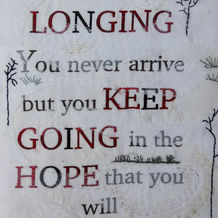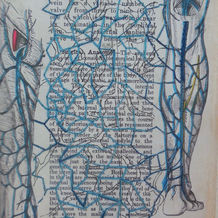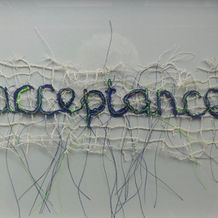ways with words 2021
Art created in support of the Orpington Ways With Words Literary Festival 2021
organised by Rotary in partnership with Orpington 1st
Brenda Parsons
I mainly use painted and stitched papers in my work and regularly stitch words cut from books and maps to bring interest and a grounding of location to my work. This interest comes from my background as a geographer and a lover of the printed and spoken word.
Coral Singleton
This is a response to a diary entry recording the 274 mile challenge to walk the Pennine Way. It is stitched and pricked with tiny sketches on torn and painted wall paper.
Elizabeth Arkell
I'd been trying to scratch my head for inspiration for this one - all sorts of ideas that I knew wouldn't pan out.
Then I thought about what has been the most important thing for me, and for so many, over the past year: the support of friends, and suddenly it just all came together. It became a labour of love, stitching this as I thought of those friends who are - or have been - so important throughout my life.
Ok - a bit melo-D but it's how it's been.
And it was a joy to actually use the learning from a series of workshops to draft out the Celtic knot border, and to do something a bit less arty and more straightforward for a change.
Fiona Freeman
My embroidered picture represents an open book with a pop up feature of a human ear entering the heart, to represent the saying
‘Open The Ears Of Your Heart’. This shows the sound of words transferring into feelings. When we listen carefully to what our heart or the Holy Spirit is telling us, we can be guided in our everyday lives. ‘ Ways With Words’ fill our world, talking and listening to each other, reading, singing, listening to music and all forms of human communication can be enjoyed.
Heather Spaulding
Poem for Tom. I produced this embroidery from a poem that I wrote for my late husband, Tom.
Black and Tan. This is based on a newspaper article which I thought relevant to a celebration of equality. It has the newspaper article actually stitched into the background with added machine embroidered word
Jan Cook
My interest in the challenges 21st century society presents us with is expressed in stitch on fabric and paper.
Janet Crowther
The Rainy Day - Henry Wadsworth Longfellow
The day is cold, and dark, and dreary;
It rains, and the wind is never weary;
The vine still clings to the mouldering wall,
But at every gust the dead leaves fall,
And the day is dark and dreary.
My life is cold, and dark, and dreary;
It rains, and the wind is never weary;
My thoughts still cling to the mouldering Past,
But the hopes of youth fall thick in the blast,
And the days are dark and dreary.
Be still, sad heart! and cease repining;
Behind the clouds is the sun still shining;
Thy fate is the common fate of all,
Into each life some rain must fall,
Some days must be dark and dreary.
Karen Butti
S Marco 101 - An imagined conversation between Venetian architect Carlo Scarpa and John Ruskin on the value of art and craftmanship using motifs from the Olivetti Showroom in St Mark’s Square and a familiar typing exercise. Machine embroidery on hand printed silk organza.
Fragments - Machine embroidered texts associated with the layers of narrative beneath the conservation work at 7 Hammersmith Terrace, home of Emery Walker co-founder of the Doves Press and friend of William Morris. Machine embroidery on handprinted silk organza
Hammersmith - The words of Thomas Cobden Sanderson who threw the Doves Press metal type into the Thames from Hammersmith Bridge to prevent anyone else but him using them. Machine embroidery on handprinted discharge cotton.
Karen Morton
This wall-hanging was principally inspired by the first story, 'The Pacific Journal of Adam Ewing' from David Mitchell's novel 'Cloud Atlas'. The second story in the novel, 'Letters from Zedelghem' prompts thoughts of how music is heard in the sounds of the world around us.
Each page of music on the wall-hanging imagines a visual response and record of random days at sea experienced by the character in the first story, on board a schooner for many weeks.
To create the character’s journal pages I re-purposed the loose leaves of a rapidly disintegrating book of music, acquired in a college library sale. The pages already embodied a fragility hovering on the edge of ruin that I felt was appropriate to the concept of a journal that had survived many weeks at sea in the haphazard accommodation of the traveller. This fragility was further exacerbated as a result of working into each page, applying tactile and visual elements instinctively. The work grew whilst imagining how the character might go about creating a response from his musings, intermeshed with the possible view, largely through a porthole, using materials that were to hand.
David Mitchell is an author skilled in transporting the reader to another time and place. In 'Cloud Atlas' he creates a credible ‘other-worldliness’ that draws you in, with each story carrying the soul or essence, which we are led to assume is essentially of the same character, throughout diverse centuries and realms.
In creating ‘Singing Sails’, my intention was to present the individual pages in a form where they could be simultaneously seen together whilst inviting individual focus. Prompting thoughts and imaginative wanderings, each viewer can create their own narrative. The materials used are muslin, paper, wax, dye and thread, pinned to an organdie background.
Maureen Lauder
Made from a 1970s newspaper, felt and stitch.
Lesley Rees
The words are taken from one of Shelley's poems: 'Stanza written near the Bay of Naples', dated 1818.
Pam Smyth
Camel and Orangutang are a response to photographer Joel Sartore’s words in his book, Vanishing: ‘Disappearing need not be the same as being gone’.
In Albatross, Pangolin and Chacoan Peccary I have played with words that describe how they are nearing extinction.
In Pandemic Words I have stitched some words we heard last year on a collage of painted linen.
Sue Evans
Bench - These small embroideries were made for an exhibition based on listening, observing and absorbing stories of visitors' experiences in the park. Mostly they were pleasant, but not always. My attention was drawn to the tragic story of a homeless man who met a violent end but was remembered with an inscription on a park bench. Taking this language of the memorial bench place, these pieces were made in response to memories, history and current events.
Hope - The single word "hope", seems apposite in our current situation. Among many definitions hope has been characterised as a weapon, a Christian virtue, tool of self-deception, the best of things, but my starting point was the comfort offered by the word. The first piece prsents the letters loosely connected so they can be manipulated into a shape to offer a soft protection and crutch from reality when all else has failed. Illustrated are its use folded and wrapped as a blindfold, prayer mat and warming scarf but imagination is the only bar to other uses that can assist the hopeful..
The second is a white flag. When nothing else works the only thing is to surrender hope. A touch of military bling is added though as the power of hope asserts its strength.
Alison Hird-Beecroft
Lines of Communication - this is about the things we say when we first meet someone or make conversation.
Have you been here before? I think I know you from somewhere. What school did you go to? Do you like his work? I think you know my friend. I do like your shoes, where did you get them?























































